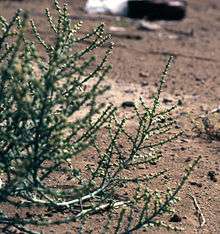Salsola stocksii
| Salsola stocksii | |
|---|---|
 | |
| Salsola stocksii | |
| Scientific classification | |
| Kingdom: | Plantae |
| (unranked): | Angiosperms |
| (unranked): | Eudicots |
| (unranked): | Core eudicots |
| Order: | Caryophyllales |
| Family: | Amaranthaceae |
| Subfamily: | Salsoloideae |
| Genus: | Salsola |
| Species: | S. stocksii |
| Binomial name | |
| Salsola stocksii Boiss. 1859 | |
| Synonyms | |
|
see text | |
Salsola stocksii is a shrub species of the family Amaranthaceae.
Description
Salsola stocksii is a sturdy, glabrous or pruinose shrub 25–80 cm tall, its branches are prostrate or ascending. The distinct, sessile, spreading leaves are terete, fleshy, to 5 mm long and 1,5 mm in diameter. The opposite branches spread nearly horizontally. The inflorescences are wide paniculate with 3–12 cm long spike-like branches with numerous flowers. Perianth segments are only 1,5 mm long. The 5 stamens are alternating with ovate staminodes. Fruiting, the perianth segments develop spreading brown wings, circa 6 mm in diameter. The seed diameter is 2,5–3 mm.
Pollination and dissemination

Salsola stocksii is pollinated by small wild bees (Hymenoptera), that were observed to collect pollen (see photo).[1] The winged fruits are dispersed by the wind (anemochory).
Distribution
Salsola stocksii is distributed in Afghanistan, Pakistan and West India (Punjab, Rajasthan), where it grows on sandy or loamy saline soils (halophyte) and limestone hills.[2]
Uses
Salsola stocksii is used as a source of crude sodium carbonate[2] (barilla or "Sajji-Khar"). The "Sajji-Khar" is added as an ingredient for unique taste of famous Bikaneri papad. The ash of this plant is used as substitute of soap for cleaning clothes and is also taken with water for treatment of internal ulcers.
Systematics
Salsola stocksii belongs to the subfamily Salsoloideae of the family Amaranthaceae. The species name was first published by Pierre Edmond Boissier in Diagnoses plantarum orientalium novarum in 1859.
Synonyms are Haloxylon stocksii (Boiss.) Benth. & Hook., and Haloxylon recurvum sensu Bunge.[2] Phylogenetic analysis revealed that the species does not belong to genus Haloxylon and has to be classified to genus Salsola.[3]
Vernacular name: It is locally known as "Khar", meaning salty.
References
- I.C.Hedge: Haloxylon.- In: Karl Heinz Rechinger et al. (Edit.): Flora Iranica Bd. 172, Chenopodiaceae: p. 315-326. Akad. Druck, Graz 1997, ISBN 3-201-00728-5. p. 321. (description, distribution)
- ↑ Gabriele Kothe-Heinrich: Revision der Gattung Halothamnus (Chenopodiaceae). Bibliotheca Botanica Bd. 143, Schweizerbart, Stuttgart 1993, ISBN 978-3-510-48014-2 (German), p. 22.
- 1 2 3 I.C.Hedge: Haloxylon.- In: Karl Heinz Rechinger et al. (Edit.): Flora Iranica Bd. 172, Chenopodiaceae: p. 315-326. Akad. Druck, Graz 1997, ISBN 3-201-00728-5. p. 321.
- ↑ Hossein Akhani, Gerald Edwards, Eric H. Roalson: Diversification Of The Old World Salsoleae S.L. (Chenopodiaceae): Molecular Phylogenetic Analysis Of Nuclear And Chloroplast Data Sets And A Revised Classification, In: International Journal of Plant Sciences, Volume 168 (6), 2007, p. 931–956.